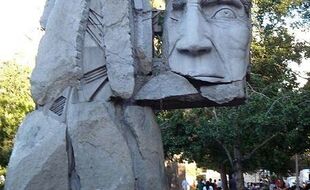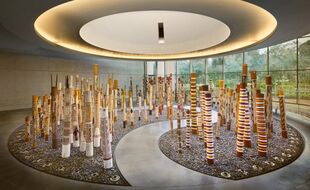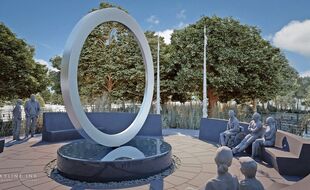Commemorating Indigenous Culture and Their Contributions to Society
Introduction
Within just a few generations, the continents of the Americas were virtually emptied of their native inhabitants – some academics estimate that approximately 20 million people may have died in the years following the European invasion (Gun Germs & Steel). Most people assume that the sufferings of indigenous peoples have been overlooked. However, these monuments help us remember and acknowledge the accomplishments that indigenous people have made. And in this digital exhibit, I will argue that these memorials are a source for commemorating the culture and contributions to society of the Indigenous peoples’. In this Exhibit, I will detail the successes and shortcomings that are present in The Aboriginal Memorial, The Monument to the Indigenous People, and The National Native American Veterans Memorial when representing the legacies of Indigenous people.

The Monument to the Indigenous People
The Monument to the Indigenous People is intended to be a representation of the bravery of the Mapuche people, the indigenous inhabitants of south-central Chile. Specifically, the restructuring of their societies to become a military force to fight off foreign invaders (Monument to the Indigenous People). Prior to the arrival of the Spaniards, the Mapuche people were a group of loosely connected farming communities with little political structure. However, they quickly unified to fight the Spanish conquistadores for 350 years (Monument to the Indigenous People). Therefore, the Mapuche people are remembered as being strong and united in their battle to fight against foreign invaders. However, this memorial does not exactly portray this proper form of history. Specifically, the memorial represents the decapitated and fractured face of a Mapuche man (Monument to the Indigenous People). Consequently, this image appears to portray the defeat of the Mapuche people by foreign invaders rather than the unity and strength of their society. Additionally, this memorial was unveiled in October 1992 which marked the 500 year anniversary of Christopher Columbus’s arrival (Monument to the Indigenous People). Again, this is commemorating more the successes of the Spanish conquistadores, and coupled with the fractured face of the Mapuche man, this memorial does a very poor job of representing the hard work and bravery of the Mapuche people. Identifications and territories explain the national identity shared by the Mapuche people to unite and battle the Spanish invaders together; however, this monument is a misrepresentation of the resilience and toughness expressed by the Mapuche people (Olson, 14).
The Aboriginal Memorial
The Aboriginal Memorial represents the different cultures of the indigenous people, the meaning, and purpose that this memorial holds. This memorial was built in commemoration of the indigenous Australians of the Central Arnhem Land who had died defending their land from European settlers since 1788 (The Aboriginal Memorial Introduction). Disease and Discrimination were the primary sources for the destruction of Aboriginal culture and the displacement of the indigenous population (The National Archives). Therefore, this memorial seeks to properly represent the different clans within the Aboriginal population and ensure that their legacy remains.
The memorial is comprised of 200 hollow log coffins that imitate the course of the Glyde River estuary which flows through the Arafura Swamp to the sea. The hollow log coffins are situated broadly according to where the artists' clans live along the river and its tributaries. The different painting styles of the groupings of logs represent common ancestors, land, language, and social affiliations (The Aboriginal Memorial Introduction).
With the positioning of the 200 logs in the memorial, the locations and cultures of each Aboriginal clan are preserved so that the uniqueness and importance of each clan can be remembered. Additionally, this memorial helps viewers understand the purpose behind the creation of the memorial. Specifically, the logs making up the memorial are based on the Dupun Ceremony, which is practiced to ensure the safe arrival of the spirit of the deceased from the earth to the land of the dead (The Aboriginal Memorial Introduction). This is relevant to the history of the Aboriginal people because they are known for dying to defend their land from European settlers. Therefore, associating death with a ritual justifies their cultural understanding that fighting for their land and preservation of their culture is worth losing their lives for. Moreover, this memorial was created in 1987, 200 years after colonialism began, which is why the presence of exactly 200 logs emphasizes the long and tumultuous struggle the Aboriginal people faced.
This memorial is an excellent representation of indigenous culture. The interplay between the layout, design, and cultural meaning embedded in the memorial emphasizes the importance of the presence of tradition and stability when constructing a memorial (Olson, 11).
/arc-anglerfish-arc2-prod-mco.s3.amazonaws.com/public/BKLZMN7PIJDHFJRWX66OIQBJVA.jpg)
The National Native American Veterans Memorial
The National Native American Veterans Memorial is a recent development commemorating the enduring service of Native Americans in every branch of the U.S. military. This memorial is important as its purpose is to ensure that Native American history and presence in society are apparent (National Native American Veterans Memorial). Additionally, the design of the memorial is representative of sacred ceremonies, prayers, and healings in the culture of Native American individuals. Specifically, the memorial consists of an elevated stainless-steel circle balanced on a carved stone drum, while incorporating water for sacred ceremonies, benches for gathering and reflection, and four lances where veterans, family members, tribal leaders, and others can tie cloths for prayers and healing (National Native American Veterans Memorial). This design is essential for the representation and preservation of Native American culture in society. Moreover, not only is Native American culture preserved, but their hard work and contributions to society are ensured to be commemorated and remembered. However, one downside is that is not as specific and representative of Native culture as the extent of the Aboriginal Memorial. For example, The National Native American Veterans Memorial does not provide any specific information on the specific individuals or groups of individuals that have served and what their accomplishments were. Although it is a good memorial as it brings necessary attention to the hard work of the Native Americas as well as their culture that has often been neglected in society, it could be improved with the specificity of the kind of military service that has been accomplished by the Native people. In order for there to truly be a sense of legitimate national unity, the knowledge of the culture and accomplishments of Native Americans needs to be more widespread and clear to understand (Olson, 14).
Conclusion
The successes and failures of constructing a proper memorial stem from the specificity and accuracy of portraying the cultures and accomplishments of the Indigenous people. It is important that the achievements and bravery of Indigenous people are properly represented so that the sufferings they went through to fight for their autonomy are not overlooked. Additionally, it is essential that the sacrifices made by Indigenous people are not forgotten and that society prioritizes the remembrance and commemoration of Indigenous culture and contribution to society.
References
Australia, National Gallery Of. “The Aboriginal Memorial Introduction.” The Aboriginal Memorial, nga.gov.au/aboriginalmemorial/home.cfm.
“Guns Germs & Steel: Variables. Smallpox.” PBS, Public Broadcasting Service, www.pbs.org/gunsgermssteel/variables/smallpox.html.
“The National Archives, British Empire.” The National Archives, www.nationalarchives.gov.uk/education/empire/g2/cs2/background.htm.
“National Native American Veterans Memorial: National Museum of the American Indian.” National Native American Veterans Memorial | National Museum of the American Indian, americanindian.si.edu/visit/washington/nnavm.
Olson, Christa J. Constitutive Visions: Indigeneity and Commonplaces of National Identity in Republican Ecuador. The Pennsylvania State University Press, 2014.
Ugc. “Monument to the Indigenous People.” Atlas Obscura, Atlas Obscura, 19 Mar. 2019, www.atlasobscura.com/places/monument-to-the-indigenous-people-monumento-....
![]()
![]()
![]()








